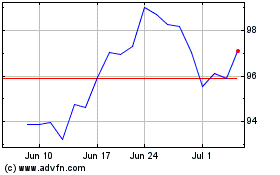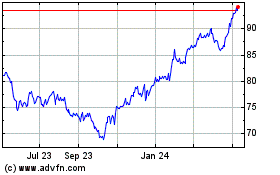Stocks in the Consumer Staples sector performed their traditional
defensive role as the broader equity markets came under pressure in
response to concerns over Europe’s sovereign debt crisis and a weak
U.S. economy. The fundamental explanation is that food, beverage,
household products and cosmetics companies that manufacture and
market consumable products, most of which are considered essential
to daily life, such as food, drink, toothpaste, deodorants, toilet
paper, etc.
As of September 18, 2011 the consumer staples sector represented
11.8% of the S&P 500 Index, up 0.4%, compared with a 10.7% drop
for the S&P 500. In 2010, the sector index grew 10.7% versus a
12.8% increase for the S&P 500 index. But with the market
shifting gear and starting to move up again over the last few
trading sessions, this defensive sector is expected to be unable to
keep pace.
Road Ahead
As referred to earlier, the macro-economic environment remains
uncertain. However, we have seen that product demands have remained
relatively stable.
Going ahead, beverage companies, which make up 22.2% of the
sector's market value, are expected to grow faster -- in the mid
single-digit to high single-digit range -- displaying the benefits
of volume growth and effective net pricing. On the other hand,
cosmetics companies can grow their earnings from higher-margin
product launches and effective advertising spending.
However, the essentially jobless recovery that defined 2010 has
lingered through 2011. Further, worsening the situation is the high
food inflation. In this environment, the less expensive private
label goods are expected to attract consumers, thereby limiting the
growth potential of branded food companies.
Further, the substantial rise in raw material prices remains a drag
on margins of most of the companies in this sector. We have seen
this trend with
Colgate Palmolive Co. (CL),
Kimberly-Clark Corporation (KMB) and
Procter & Gamble Co. (PG) in recent days.
Therefore, to survive in the environment of escalating prices, many
companies in the consumer staples sector have "right-sized"
portions and packaging of their products to pass on the higher
prices to consumers.
PepsiCo Inc. (PEP) had
reduced the Lay's "Family Size" potato-chip bag from 16 ounces to
14 ounces in 2009, due to rising grain prices.
HJ Heinz
Co. (HNZ) has reduced the portions of its several
products, including its flagship Heinz 57 sauce, which now comes in
a 4-ounce smaller package with no reduction in price. The reason
behind this reduction remains the rising cost of wholesale
tomatoes, which have more than tripled in 2010 from the previous
year.
It is expected that higher wheat costs will begin to affect cereal
and bakery product prices over the next few months, causing prices
to rise 3.5% to 4.5% overall in 2011.
In spite of the price hike, these companies bring out new
innovative products to cater to the ever-changing demands of
customers.
Heinz Ketchup’s Dip & Squeeze product was a breakthrough
dual-function ketchup package for the foodservice industry and the
launch of Simply Heinz Tomato Ketchup for the retail market. From
the first plastic ketchup bottle to Top-Down and Fridge Door Fit,
Heinz continues to lead the industry in ketchup packaging
innovation.
Health, beauty and other products also remain well positioned as
they constantly introduce new products especially targeted at young
women.
Unilever plc (UL) has recently launched
‘Dove Ultimate Go Sleeveless’ which claims that its specialized
moisturizers can give women better-looking underarms in five
days.
Likewise, the top global beauty and direct selling brand,
Avon Products Inc. (AVP) continues to
revolutionize the beauty industry by launching innovative,
first-to-market products using Avon-patented technology. The
flagship Avon Color brand sells 4 tubes of lipcolor every second.
Besides, its brands like Skin So Soft continue to evolve to meet
today’s personal care needs.
Among discounters,
Supervalu Inc. (SVU) has
developed its retail operations primarily through new store
development, adding merchandise to the existing stores and
increasing the number of replacement food distribution centers. The
company completed 11 traditional store remodels and opened 18
Save-A-Lot locations in the first quarter of 2012, and plans to
complete 55 to 75 store remodels in fiscal 2012 and open 160
Save-A-Lot stores by fiscal 2012.
Wal-Mart Stores, Inc. (WMT) that runs chains of
large discount department stores and warehouse stores also operated
803 discount stores, 2,747 supercenters, 158 neighborhood markets,
and 596 Sam’s Clubs in the United States at the end of fiscal 2010.
In April, 2011, the company announced a new "Walmart To Go" home
delivery system where customers will be able to order specific
items offered on their website such as groceries, toiletries and
household supplies.
To generate employment and to protect the environment, Walmart also
planned to install solar-power panels in more than 60 stores in
California, which means that 75% of Walmart stores will have solar
power. Through this solar program, Walmart has cut down its energy
expenses by more than a million dollars, and created hundreds of
new full-time jobs.
OPPORTUNITIES
Though temporarily impacted by inflation, there are companies,
which are cash rich and can withstand the current economic
headwinds.
Procter & Gamble Co. (PG) is one of
the well positioned companies in the consumer staples sector. The
company generated approximately $9.9 billion in free cash flow in
fiscal 2011, and repurchased $7 billion worth of shares in fiscal
2011 and increased its quarterly dividend by 9% in April, paying
$5.8 billion in dividends to shareholders in fiscal 2011.
Procter & Gamble also continues to see healthy growth rates in
developing markets. In fiscal year 2011, the company experienced
unit volume increases in all reportable segments due to investments
in innovation and market expansions, such as Olay and Head &
Shoulders in Brazil, Gillette Guard in India. The results thus led
to inflated guidance for net sales and organic sales (based on
solid volume momentum, partially offset by product mix and pricing)
in the range of 5%–9% and 3%–6%, respectively, for fiscal year
2012.
However, margins were impacted by higher commodity costs and
unfavorable product mix, which resulted in a 120-bp gross margin
contraction in the fourth quarter and 140 basis points in fiscal
year 2011. Nevertheless, the company’s expansion of its portfolio
of brands, both through internal development and acquisition
remains encouraging. On a long-term basis we are Neutral on the
stock, and on a short-term basis the stock has a Zacks #3 Rank
which implies a Hold rating.
We can also see the global net sales of
Philip Morris
International Inc. (PM) growing 17.2% year over year to
$8.3 billion in the second quarter of 2011, including favorable
currency of $494 million. Philip Morris’ earnings also surpassed
the Zacks Consensus Estimate to $1.34, attributable to price
increases and strong volume growth in Asia.
Concurrently, the company has raised its outlook for fiscal 2011.
Phillip Morris expects earnings in the range of $4.70 to $4.80 for
fiscal 2011, reflecting a growth of approximately 20.0% to 22.5%
from $3.92 earned in 2010.
Philip Morris is well positioned to capitalize on its strong brand
in emerging economies, while enjoying the benefit of reduced
liability risk in developed countries, since its operations are
globally diversified.
However, there have been significant increases in cigarette-related
taxes which might impact the company’s cigarette volume and sales
due to lower consumption levels, a shift in sales from manufactured
cigarettes to other tobacco products and a shift from the premium
price to the mid-price or low-price cigarettes.
In spite of the above difficulties, management continued to enhance
shareholder value through share repurchases and dividends. During
the second quarter of 2011, the company repurchased as many as 22.7
million shares worth $1.5 billion; while recently, the company
raised its quarterly dividend by 20.3% to 77 cents per share, which
will be paid on October 11, 2011 to shareholders of record as of
September 27, 2011.
This was the biggest and the fourth consecutive annual dividend
increment after the company spun out from Altria in 2008. The
previous three dividend increases were 17.4%, 7.4% and 10.4% in
2008, 2009 and 2010, respectively. On a long term basis we are
Neutral on the stock, and on a short term basis the stock has a
Zacks #3 Rank which implies a Hold rating.
WEAKNESSES
Kimberly-Clark Corporation (KMB) is one of the world’s
leading manufacturers of health and hygiene products, and commands
a strong portfolio of well-established brands. In the most recent
quarter, the company’s earnings and margins were hit by significant
input cost inflation and a higher effective tax rate.
Further, the company assumes input cost inflation to be in the
range of $650 million–$750 million compared to the previous
assumption of $450 million–$550 million, primarily due to higher
costs for polymer resin, superabsorbent, adhesives and other
packaging materials. On a long-term basis we are Neutral on the
stock, and on a short-term basis the stock has a Zacks #3 Rank
which implies a Hold rating.
Altria Group (MO), the manufacturer and seller of
cigarettes, wine and other tobacco products, is also seeing volume
declines in its cigarette segment due to growing health
consciousness among consumers, a ban on public smoking as well as
high excise duties on tobacco products and other legislative
controls. On a long-term basis we are Neutral on the stock, and on
a short-term basis the stock has a Zacks #3 Rank which implies a
Hold rating.
Fred's Inc. (FRED), which operates discount
general merchandise stores across 15 states in the southeastern US,
has experienced tough retail conditions across the markets in 2011.
With rising account receivables and declining cash assets, the
company is finding it difficult to maximize its revenue in this
state of the economy.
Moreover, the company operates in a highly fragmented industry and
faces intense competition from national, regional and local
retailing establishments. On a long-term basis we believe that the
stock will Underperform, and on a short-term basis the stock has a
Zacks #5 Rank, which implies a Strong Sell rating.
Being a global manufacturer and marketer of high-quality brand
products,
Sara Lee Corporation (SLE) also faces
tremendous inflationary pressure and severe competition from
several branded and private label products. While combating the
high price of coffee and meat by raising prices, the company is
sacrificing volume. Moreover, strict regulations imposed by several
authorities as well as inherent risks associated with the food
industry like contamination, wastage and recall of products affect
sales and the confidence of customers.
Although Sara Lee’s fourth quarter 2011 earnings of 20 cents were
decently ahead of the year-ago period and in line with the Zacks
Consensus Estimate, we do not see any solid ground which can hold
the top line at decent levels. The company is undertaking strategic
disinvestments to cope with higher expenses. It is also planning to
split itself into two businesses.
However, the spin-off is subject to clearance under several
regulations. On a long-term basis we are Underperform on the stock,
and on a short-term basis the stock has a Zacks #5 Rank, which
implies a Strong Sell rating.
AVON PRODS INC (AVP): Free Stock Analysis Report
COLGATE PALMOLI (CL): Free Stock Analysis Report
FREDS INC (FRED): Free Stock Analysis Report
HEINZ (HJ) CO (HNZ): Free Stock Analysis Report
KIMBERLY CLARK (KMB): Free Stock Analysis Report
ALTRIA GROUP (MO): Free Stock Analysis Report
PEPSICO INC (PEP): Free Stock Analysis Report
PROCTER & GAMBL (PG): Free Stock Analysis Report
PHILIP MORRIS (PM): Free Stock Analysis Report
SARA LEE (SLE): Free Stock Analysis Report
SUPERVALU INC (SVU): Free Stock Analysis Report
UNILEVER PLC (UL): Free Stock Analysis Report
WAL-MART STORES (WMT): Free Stock Analysis Report
Zacks Investment Research
Colgate Palmolive (NYSE:CL)
Historical Stock Chart
From May 2024 to Jun 2024

Colgate Palmolive (NYSE:CL)
Historical Stock Chart
From Jun 2023 to Jun 2024
